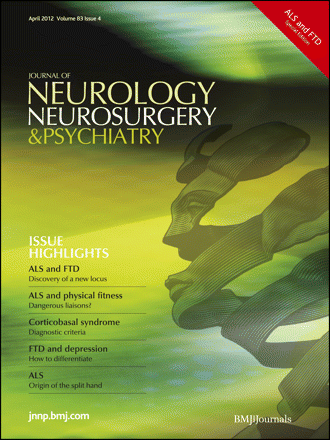In the April issue of the journal, we launched the first of JNNP’s mini-themed issues, with a focus on how clinical research was making in-roads in the search for the common and overlapping threads that bind amyotrophic lateral sclerosis (ALS) and fronto-temporal dementia (FTD). This theme was particularly timely, given the recent discovery of the hexanucleotide expansion on chromosome 9 that appears to underlie a large proportion of familial ALS and FTD, in addition to apparently sporadic disease.
The themed issue of JNNP provided insight into the clinical overlap between ALS and FTD from experts at the cutting edge, with manuscripts covering the early pathological studies originally published in JNNP by Marion Smith (selected as the Impact Commentary); to clinical descriptions of the recent genetic overlap involving chromosome 9 from one of the key clinican-scientitsts involved, Bryan Traynor; whilst also considering an evolved understanding about ALS disease-onset with description of clinical signs such as the ALS ‘split hand’; through to trends in clinical management across the rapidly transforming landscape.
With discovery and advancement of the concepts surrounding ALS and FTD, there inevitably arise further questions, not just for these disorders, but more generally. For instance, in neurodegenerative syndromes such as Alzheimer disease and Parkinson’s disease, the type and progression of pathology within the brain has been better defined. These diseases tend to occur in a slowly progressive manner, most commonly in people of advanced age. In contrast, the prevalence of ALS and FTD is highest in people aged 40-60 years, with an as yet unexplained reduction in prevalence in older age cohorts. Furthermore, while there is initial focal degeneration in frontotemporal and motor pathways, ALS and FTD appear unique among neurodegenerative syndromes in that there are three, largely mutually exclusive, underlying protein abnormalities. In contrast to Alzheimer disease patients, who manifest the same protein abnormalities, neural involvement in patients with FTD and ALS is characterised by variable cellular pathologies, with aggregation of tau protein, tar DNA-binding protein-43 (TDP43) and fused in sarcoma (FUS) protein. Variability in the initial location and subsequent spread of degeneration within the brain appears to give rise to variable clinical syndromes, although precisely how this occurs remains unclear.
Where to from here? Clearly, a more coherent understanding about the degree of cognitive impairment in ALS, and the implications of motor dysfunction in FTD needs to be developed. Problems with judgement, impulsivity and a more general deterioration in the ability to perform routine daily tasks may be a source of significant disability in ALS. Cognitive and executive dysfunction will inevitably impair patient compliance, decision-making abilities and may even potentially raise ethical and medico-legal concerns. As such, there remains a critical need to be able to differentiate the pathological subtypes and resultant clinical phenotypes of these disorders in order to develop adequate mechanistic treatments, particularly as these conditions are generally the most rapidly-progressive neurodegenerative diseases.
Following on from this initial themed issues, JNNP will have a complete issue covering Movement Disorders to be launched in October. Manuscripts will cover Movement Disorder concepts from the time of the Foundation Editor of the journal Kinnier Wilson (referred to as the Marco Polo of the basal ganglia), through to the present.
We look forward to your feedback!
